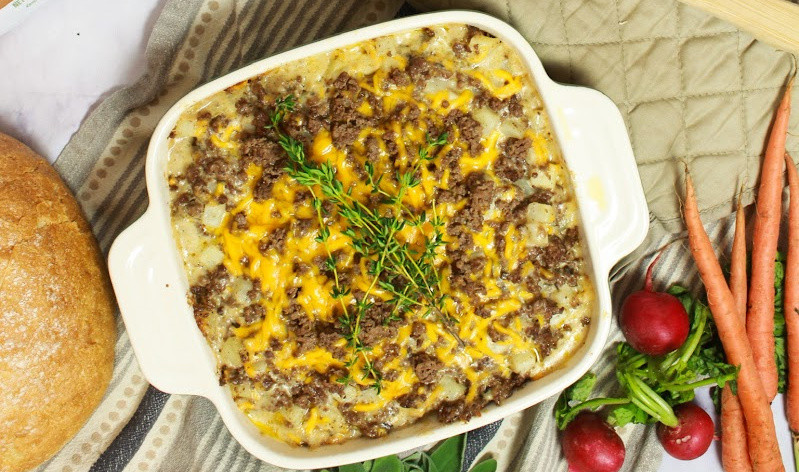Three Unforgettable Chicken Back Recipes
Next time you roast up a succulent whole chicken, don’t toss the carcass! The chicken’s back—the part with the ribs and backbone—is a treasure trove of flavor and nutrients. It’s packed with juicy meat, collagen, and protein. Not only does it give you a delicious meal, but it’s also a fantastic way to embrace the nose-to-tail approach in your cooking. Want to know how to cook with chicken backs? Here, we’ll walk through three recipes that make the most of this often-overlooked chicken cut. What Is a Chicken Back? The chicken back is the part left behind after you’ve carved off the breast, wings, and legs. Chicken bones are collagen-rich, making them fantastic for creating rich, flavorful dishes and broths. Plus, it’s got a mix of tender, light and dark meat that’s bursting with flavor. What Can You Do with Chicken Backs? Chicken backs are versatile, as you’ll discover below. They’re perfect for creating a variety of nutritious and delicious meals. Chicken backs are also fantastic for making homemade bone broths or as a wholesome treat for your dog. By incorporating them into your meals, you’ll enjoy their rich flavor while reducing food waste and making the most of every part of the chicken. How to Cook Chicken Backs: 3 Easy Recipes to Try at Home It's time to roll up your sleeves and get cooking. Here are three delicious chicken back recipes that will have everyone coming back for seconds. 1. Salt and Pepper Chicken Backs with Golden Rice Who doesn’t love a one-pot wonder? This nutritious crowd-pleaser is hearty and nourishing and comes together in no time. It’s sure to become a family favorite. You’ll need the following ingredients: 2 Lbs chicken backs 2 Cups long-grain rice 4 Cups chicken broth 1 Large onion, chopped 2 Cloves garlic, minced 1 Bell pepper, chopped 2 TBSP Extra virgin olive oil 1 TSP Smoked paprika 1 TSP Salt ½ TSP Black pepper 1/4 TSP Turmeric (optional) Fresh parsley, chopped (for garnish) Here’s what to do: Rinse the chicken backs under cold water. Pat dry thoroughly with paper towels and generously season both sides with salt, pepper, and smoked paprika. Heat 2 TBSPs of extra virgin olive oil in a large pot or Dutch oven over medium heat, then add the chicken backs. Cook for 5-7 minutes, or until they develop a golden brown color. Use tongs to turn the chicken and brown on all sides. Once browned, remove it from the pot and set it aside on a plate. In the same pot, add the chopped onion and bell pepper. Cook, stirring occasionally, for 5 minutes or until the vegetables soften and the onions are translucent. Add the minced garlic and cook for an additional minute. Add 1 cup of rice to the pot with the vegetables. Stir well to coat the rice with the oil and vegetable mixture. Cook the rice for 2-3 minutes, allowing it to toast lightly. Return the browned chicken backs to the pot. Pour in 4 cups of chicken broth and sprinkle in 1/2 TSP of turmeric (if using). The turmeric will give your dish a lovely golden color and subtle peppery flavor. Stir to combine. Increase the heat to high and bring the mixture to a boil. Once boiling, reduce the heat to low. Cover the pot and let simmer gently for 20-25 minutes. If using brown rice, you may need to increase the cooking time to 35-40 minutes. After cooking, remove the pot from the heat but keep it covered. Let it sit for 5 minutes to allow the rice to firm up and absorb any remaining liquid. Carefully remove the chicken backs from the pot and shred the meat off the bones, if desired. Return the shredded chicken to the pot, or serve the chicken backs whole if preferred. Garnish with freshly chopped parsley and serve alongside a crisp salad or steamed green beans. 2. Healing Chicken Back Soup This warming soup recipe is nutrient-dense and kind to your digestive system. It also makes a big batch, so you can freeze them and have meals on hand when you’re short on time. The ingredients you’ll need are: 2 Lbs chicken backs 8 Cups water 2 Large carrots, chopped 2 Celery stalks, chopped 1 Large onion, chopped 2 Cloves garlic, minced 1 Bay leaf 1 TSP Dried thyme Salt and pepper to taste 1 Cup egg noodles (optional) Fresh parsley, chopped (for garnish) Here are step-by-step instructions for this wonderfully nourishing soup: Rinse the chicken backs under cold water. Place them in a large pot and add 8 cups of water. Bring the water to a rolling boil over high heat. Once boiling, reduce the heat to low to maintain a gentle simmer. As the broth simmers, foam will rise to the surface. Use a ladle or a spoon to skim off the foam and discard it. Add chopped carrots, celery, onion, minced garlic, thyme, and the bay leaf. Season with salt and pepper to taste. Stir everything together and let the mixture simmer for an additional 30 minutes. After simmering, remove the chicken backs from the pot and place them on a cutting board. Let them cool slightly so you can handle them. Once cool enough, remove the meat and discard the bones. Shred or chop the chicken meat into bite-sized pieces and return it to the pot. If you’re using egg noodles, add them to the pot. Cook until the noodles are tender, usually about 8-10 minutes. If you prefer a broth-only soup, skip this step. Taste the soup and adjust the seasoning with additional salt and pepper, if needed. Once you’re happy with the taste, ladle the soup into bowls and garnish with freshly chopped parsley. Serve on its own or with crusty sourdough bread. 3. Roasted chicken backs with herby potatoes Try this simple, tasty sheet pan recipe for a twist on roast chicken. We’ve listed rosemary and thyme as the herbs below, but you can use whatever you like: cajun seasoning, paprika, or curry powder. They all work fantastically. For this recipe, gather the following ingredients: 2 Lbs chicken backs 4 Large potatoes, cut into wedges 3 Large carrots, cut into chunks 1 Large onion, cut into wedges 3 TBSPs Extra virgin olive oil 1 TSP Dried rosemary 1 TSP Dried thyme 1 TSP Garlic powder 1 TSP Salt 1/2 TSP Black pepper Fresh lemon juice (optional) Here’s what to do. Set your oven to 400°F (200°C) and let it preheat while you prepare the ingredients. Rinse the chicken backs under cold water and pat them dry with paper towels. Season generously with salt, pepper, garlic powder, dried rosemary, and thyme. In a large bowl, toss the potato wedges, carrot slices, and chopped onion with the olive oil—season with salt and pepper. Spread the seasoned chicken backs and vegetables in a single layer on a large baking sheet. Place the baking sheet in the preheated oven. Roast for 45-55 minutes, or until the chicken is cooked through and reaches an internal temperature of 165°F (74°C) and the vegetables are tender and golden brown. Remember to stir the vegetables halfway through cooking to ensure even roasting. Remove the roasted chicken and vegetables from the oven and let them rest for a few minutes. If you like, drizzle with a dash of fresh lemon juice for a bright, citrus flavor. Serve this dish as it is or alongside a fresh summer salad. Order Your Chicken Backs Today! Work your way through these delicious recipes with our ethical pasture-raised chicken. You can either order a whole chicken or purchase ready-to-go chicken backs straight from our online store. Happy cooking!

















